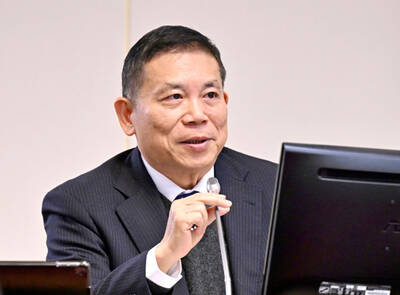Taiwan Semiconductor Manufacturing Co (TSMC, 台積電) yesterday posted its weakest quarterly net profits in about four-and-half years, largely due to flagging demand for premium smartphones and customers’ inventory corrections.
TSMC’s net profits plunged 31.6 percent to NT$61.39 billion (US$1.99 billion) in the quarter ending on March 31, compared with NT$89.79 billion in the same period last year.
That represents a decline of 38.6 percent from NT$99.98 billion in the previous quarter.
The result fell short of analysts’ expectations, as Credit Sussie Group AG’s had forecast NT$62.11 billion, while Citigroup Market Inc had said NT$61.6 billion.
The Hsinchu-based company, which is the sole chip supplier to Apple Inc’s iPhone X series, said the worst was over and it expected a strong rebound in the second half of this year, buoyed mainly by chips used in clients’ new high-end smartphones, as well as those for the initial deployment of 5G and high-performance-computing applications.
Those applications would boost demand for its 7-nanometer chips and improve its factory utilization, reversing the overcapacity expected in the first half of the year, TSMC said.
“Moving into the second quarter of this year, while economic factors and mobile product seasonality still linger, we believe we might have passed the bottom of cycle of our business,” chief executive C.C. Wei (魏哲家) told an investors’ conference. “We are seeing customers’ demand stabilizing.”
TSMC said it expects customers to reduce inventory substantially to approach the seasonal level in the middle of this year.
For the whole year of this year, TSMC still expects a “slight” growth in revenue from last year’s NT$1.03 trillion, Wei said.
That compares with the zero growth estimate given for the worldwide semiconductor industry, excluding the memorychip sector.
Smartphone platform and HPC platforms, two of the company’s major product categories, were expected to grow at a high-single-digit percentage this year, excluding cryptocurrency chips, Wei said.
“We are gaining market share along with our [smartphone] customers,” Wei said. “Silicon content for high-end smartphones is also on the rise.”
HiSilicon Technologies Co (海思半導體), the chip designing arm of China’s Huawei Technologies Co Ltd (華為), is one of TSMC’s top clients.
With 15 percent market share worldwide, Huawei saw its ranking move up one notch last quarter to become the world’s No. 2 smartphone vendor, from third place in the fourth quarter of last year, market researcher TrendForce Corp’s (集邦科技) ranking showed.
For this quarter, TSMC expects revenue to grow about 7 percent to between US$7.55 billion and US$7.65 billion, compared with NT$218.7 billion last quarter.
The growth is largely attributable to wafer shipments, which last quarter were affected by a problem in February with the photoresist material used in wafer production.
Gross margin is to improve to between 43 percent and 45 percent this quarter from 41.3 percent last quarter, the chipmaker predicted.
It is still aiming for 50 percent growth in gross margin for the second half of this year and in the long run, the company said.
TSMC kept its capital spending for this year unchanged at a range between US$10 billion and US$11 billion.

Taiwan will prioritize the development of silicon photonics by taking advantage of its strength in the semiconductor industry to build another shield to protect the local economy, National Development Council (NDC) Minister Paul Liu (劉鏡清) said yesterday. Speaking at a meeting of the legislature’s Economics Committee, Liu said Taiwan already has the artificial intelligence (AI) industry as a shield, after the semiconductor industry, to safeguard the country, and is looking at new unique fields to build more economic shields. While Taiwan will further strengthen its existing shields, over the longer term, the country is determined to focus on such potential segments as

UNCERTAINTY: Innolux activated a stringent supply chain management mechanism, as it did during the COVID-19 pandemic, to ensure optimal inventory levels for customers Flat-panel display makers AUO Corp (友達) and Innolux Corp (群創) yesterday said that about 12 to 20 percent of their display business is at risk of potential US tariffs and that they would relocate production or shipment destinations to mitigate the levies’ effects. US tariffs would have a direct impact of US$200 million on AUO’s revenue, company chairman Paul Peng (彭雙浪) told reporters on the sidelines of the Touch Taiwan trade show in Taipei yesterday. That would make up about 12 percent of the company’s overall revenue. To cope with the tariff uncertainty, AUO plans to allocate its production to manufacturing facilities in

COLLABORATION: Given Taiwan’s key position in global supply chains, the US firm is discussing strategies with local partners and clients to deal with global uncertainties Advanced Micro Devices Inc (AMD) yesterday said it is meeting with local ecosystem partners, including Taiwan Semiconductor Manufacturing Co (TSMC, 台積電), to discuss strategies, including long-term manufacturing, to navigate uncertainties such as US tariffs, as Taiwan occupies an important position in global supply chains. AMD chief executive officer Lisa Su (蘇姿丰) told reporters that Taiwan is an important part of the chip designer’s ecosystem and she is discussing with partners and customers in Taiwan to forge strong collaborations on different areas during this critical period. AMD has just become the first artificial-intelligence (AI) server chip customer of TSMC to utilize its advanced

Chizuko Kimura has become the first female sushi chef in the world to win a Michelin star, fulfilling a promise she made to her dying husband to continue his legacy. The 54-year-old Japanese chef regained the Michelin star her late husband, Shunei Kimura, won three years ago for their Sushi Shunei restaurant in Paris. For Shunei Kimura, the star was a dream come true. However, the joy was short-lived. He died from cancer just three months later in June 2022. He was 65. The following year, the restaurant in the heart of Montmartre lost its star rating. Chizuko Kimura insisted that the new star is still down